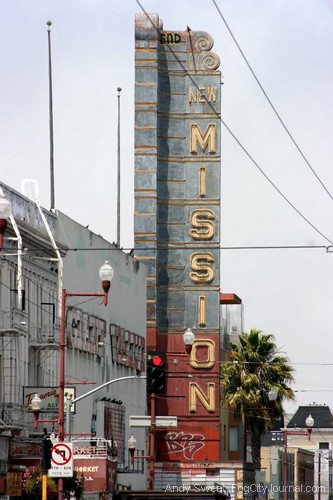
Alamo Drafthouse could make use of California’s Mills Act, which can reduce property taxes through agreed renovations and preservation of the existing historic New Mission Theater. Photo by Andy Sweet.
August 15, 2012
An image of historic art deco buildings, not too unlike San Francisco’s mid-Market in its prime, illuminated a slideshow introduction to a long-running revitalization effort that has transformed a once-blighted downtown Los Angeles into a bustling and desirable housing market.
It’s called adaptive reuse.
Trudi Sandmeier, who worked as director of education for the Los Angeles Conservancy, showcased the tools at an urban planner’s disposal, including tax exemptions and government programs that can transform largely-defunct, historic buildings at a recent San Francisco Planning and Urban Research Association forum.
“So you want to go to L.A. now don’t you?” said Sandmeier, standing next to images of art deco-era buildings before and after their adaptive reuse–an effort that San Francisco city planners only dream of undertaking.
More than Over 600 historic buildings have been repurposed in Los Angeles compared to some five buildings in San Francisco.
The lunchtime forum paralleled another event: the passing of Supervisor Scott Weiner’s Historic Building Tax Incentive legislation early this month, which will expand access to the Mills Act.
“Our process is cumbersome, lengthy, expensive, and unpredictable. As a result, we have almost no Mills Act contracts. My legislation streamlines the process for Mills Act contracts, making the process simpler and more predictable,” said Scott Weiner in a press release.
The legislation will create a 10-year contract with owners of historic buildings who find that maintaining the often poorly-aged buildings extremely expensive by abating property taxes for historic buildings, which would potentially reduce property taxes on historical properties by 50 percent.
While applauded by architects and historic preservationists, the upgrades have had an unintended effect: skyrocketing housing costs out of reach of most residents. The development of expensive housing in the historic district also meets the cusp of a post-Mexican era Los Angeles that cannot afford the housing that’s being built above their business district. A two-room apartment rents runs for an average of $3,000.
The rehabilitation has also realigned dangerous areas of Los Angeles.
Before reuse began in 1996, “you could shoot a cannonball down the street and not hit anyone,” Sandmeier said. Today, the number of residential units has grown from 11,000 to 40,000.
The adaptive reuse also speaks to San Francisco’s current acute housing shortage and increasing rent prices, which often pushes young urbanites across the Bay and reduces access to low-income communities, which can be seen in the sprawling gentrification of the Mission District.
“I do think that adaptive reuse alone does not ensure cultural preservation and this is why other planning tools need to be developed to promote cultural preservation,” said San Francisco Architectural Heritage Project Manager Desiree Smith. Her organization is working on preservation planning in the Japantown and South of Market Districts, like the three-story tall St. Joseph’s Cathedral, which is to be redeveloped into offices.
The preservation of historic buildings also provides a “tangible” connection to the past, said Smith.
The revitalization of the buildings in Los Angeles was nonetheless stunning. Sometimes simple measures achieved spectacular effects. For instance, the Chester Williams building appeared new again after workers sprayed the concrete exterior with water and removed retail signage.
The 1999 Adaptive Reuse Ordinance streamlined the process of transforming historic buildings into live-work lofts and housing units under the guidance of Hamid Behad, director of adaptive reuse projects.
Her slideshow showed before-and-after images of sometimes brilliantly-re-imagined commercial spaces or posh apartments that inhabit once-empty floors of downtown skyscrapers that had seen their prime in the 1930s or earlier, and reinforced the purpose of the redevelopment in the historic area.
“San Francisco has the opportunity to reinforce the area’s historic environment with its small-size industrial character,” said Mike Buhler, Executive Director of San Francisco Architectural Heritage.
Many buildings utilized only their ground-floor units while leaving their upper floors uninhabited, charging ground-level retail tenants high rents. Although these upper floors are now inhabited with billions of dollars invested in their development, rent hasn’t changed for the businesses that preceded this new, expensive housing market.
Preserving the surrounding cultural significance of a community while restoring a historic building through adaptive reuse promises to be a balancing act.
But it could assist and enrich the development of new businesses like the Alamo Drafthouse, which will inhabit the defunct New Mission Theater, which was announced to open in Fall 2013 according to a recent press release.
“We can take cues from Los Angeles’ adaptive reuse,” said SPUR Board Director Larry Burnett.

 The Hunger Site
The Hunger Site
No Comments
Comments for Creative Historic Reuse Inspires Urban Planning are now closed.